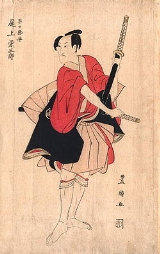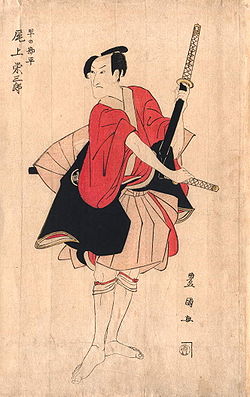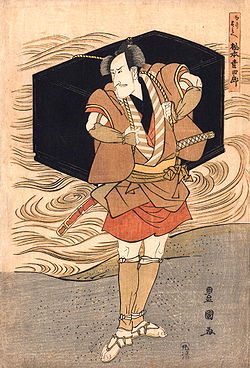
Toyokuni
Encyclopedia
Utagawa Toyokuni (Japanese: 歌川豐國), also often referred to as Toyokuni I, to distinguish him from the members of his school
who took over his gō (art-name
) after he died, was a great master of ukiyo-e
, known in particular for his Kabuki
actor prints. He was one of the heads of the renowned Utagawa school
of Japanese woodblock artists, and was the person who really moved it to the position of great fame and power it occupied for the rest of the nineteenth century.

, whose pupil was the great landscape artist Hiroshige
. In recognition of his artistic ability, Toyokuni took the name Utagawa Toyokuni, in the common practise of using one syllable of his master's name, shortly thereafter.
Toyokuni seems not to have been an intuitive genius determined to forge a new path; rather, he seems to have studied intently those who came before him, particularly Utamaro
, and through a great deal of hard work produced first a mastery, and then a synthesis of their styles, and created a style of his own.
He was known mostly for his prints related to the Kabuki theatre, in particular his actor portraits, a field which he took to new heights, although he also produced bijinga
.
 In his actor prints, like Sharaku
In his actor prints, like Sharaku
, one sees the real subject; but his prints merely portrayed what he saw, unlike Sharaku who exaggerated those aspects he saw as the most key. It is said of Toyokuni's prints that they recreate exactly what one would see on stage; they show actors acting, not merely just pictures of actors.
Together, these characteristics made Toyokuni's prints far more popular among the crowd of theatre-goers than Sharaku's, although history has come to judge Sharaku the keener observer, and greater artist.
This popularity may in part have been his undoing, though. From 1803 through 1817, his work became more static, even as it became more popular. He continued to produce large quantities of prints, but the quality as a rule did not match that of his earlier days, although occasional prints from this period show his old brilliance.
He died in Edo, surrounded by many of his pupils, in 1825, at the age of 57.
 Toyokuni's two major pupils were the woodblock print masters Kunisada
Toyokuni's two major pupils were the woodblock print masters Kunisada
and Kuniyoshi, but he had a host of students in his school. Indeed, so powerful was the Utagawa school after Toyokuni's time that almost every Japanese print artist of note either had one of these two characters in his gō, or, like Yoshitoshi
, was a student of one who did.
His gō, "Toyokuni", was initially used after his death by his son-in-law, Toyoshige
, who is therefore known to use as Toyokuni II. Thereafter, it was handed down and used by each head of the Utagawa school
in turn. Kunisada is thus also known as Toyokuni III.
However, his work captured the world around him, particularly the Kabuki theatre, with great clarity, and his style was a step forward; in addition, it was commercially successful, and thus freed woodblock prints from many of the restrictive canons which had limited previous generations of artists.
Utagawa school
The was a group of Japanese woodblock print artists, founded by Toyoharu. His pupil, Toyokuni I, took over after Toyoharu's death and raised the group to become the most famous and powerful woodblock print school for the remainder of the 19th century....
who took over his gō (art-name
Art-name
An art-name is a pseudonym, or penname, used by an East Asian artist, which they sometimes change. The word and the idea to use a pseudonym originated from China, then became popular in other East Asian countries ....
) after he died, was a great master of ukiyo-e
Ukiyo-e
' is a genre of Japanese woodblock prints and paintings produced between the 17th and the 20th centuries, featuring motifs of landscapes, tales from history, the theatre, and pleasure quarters...
, known in particular for his Kabuki
Kabuki
is classical Japanese dance-drama. Kabuki theatre is known for the stylization of its drama and for the elaborate make-up worn by some of its performers.The individual kanji characters, from left to right, mean sing , dance , and skill...
actor prints. He was one of the heads of the renowned Utagawa school
Utagawa school
The was a group of Japanese woodblock print artists, founded by Toyoharu. His pupil, Toyokuni I, took over after Toyoharu's death and raised the group to become the most famous and powerful woodblock print school for the remainder of the 19th century....
of Japanese woodblock artists, and was the person who really moved it to the position of great fame and power it occupied for the rest of the nineteenth century.

Biography
He was born in Edo, the son of Kurohashi Gorobei, a carver of dolls and puppets, including replicas of Kabuki actors. Toyokuni was apprenticed to the first head of the Utagawa house, Utagawa Toyoharu, whom his father knew well and who lived nearby, at about the age of 14. One of his fellow pupils under Toyoharu was ToyohiroToyohiro
, birth name Okajima Tōjiro , was a Japanese ukiyo-e artist and painter. He was a member of the Utagawa school and studied under Utagawa Toyoharu, the school's founder...
, whose pupil was the great landscape artist Hiroshige
Hiroshige
was a Japanese ukiyo-e artist, and one of the last great artists in that tradition. He was also referred to as Andō Hiroshige and by the art name of Ichiyūsai Hiroshige ....
. In recognition of his artistic ability, Toyokuni took the name Utagawa Toyokuni, in the common practise of using one syllable of his master's name, shortly thereafter.
Toyokuni seems not to have been an intuitive genius determined to forge a new path; rather, he seems to have studied intently those who came before him, particularly Utamaro
Utamaro
was a Japanese printmaker and painter, who is considered one of the greatest artists of woodblock prints . His name was romanized as Outamaro. He is known especially for his masterfully composed studies of women, known as bijinga...
, and through a great deal of hard work produced first a mastery, and then a synthesis of their styles, and created a style of his own.
He was known mostly for his prints related to the Kabuki theatre, in particular his actor portraits, a field which he took to new heights, although he also produced bijinga
Bijinga
Bijinga , is a generic term for pictures of beautiful women in Japanese art, especially in woodblock printing of the ukiyo-e genre, which predate photography...
.

Sharaku
is widely considered to be one of the great masters of the woodblock printing in Japan. Little is known of him, besides his ukiyo-e prints; neither his true name nor the dates of his birth or death are known with any certainty...
, one sees the real subject; but his prints merely portrayed what he saw, unlike Sharaku who exaggerated those aspects he saw as the most key. It is said of Toyokuni's prints that they recreate exactly what one would see on stage; they show actors acting, not merely just pictures of actors.
Together, these characteristics made Toyokuni's prints far more popular among the crowd of theatre-goers than Sharaku's, although history has come to judge Sharaku the keener observer, and greater artist.
This popularity may in part have been his undoing, though. From 1803 through 1817, his work became more static, even as it became more popular. He continued to produce large quantities of prints, but the quality as a rule did not match that of his earlier days, although occasional prints from this period show his old brilliance.
He died in Edo, surrounded by many of his pupils, in 1825, at the age of 57.
Pupils

Kunisada
Utagawa Kunisada was the most popular, prolific and financially successful designer of ukiyo-e woodblock prints in 19th-century Japan...
and Kuniyoshi, but he had a host of students in his school. Indeed, so powerful was the Utagawa school after Toyokuni's time that almost every Japanese print artist of note either had one of these two characters in his gō, or, like Yoshitoshi
Yoshitoshi
Tsukioka Yoshitoshi was a Japanese artist.He is widely recognized as the last great master of Ukiyo-e, a type of Japanese woodblock printing. He is additionally regarded as one of the form's greatest innovators. His career spanned two eras – the last years of feudal Japan, and the first years of...
, was a student of one who did.
His gō, "Toyokuni", was initially used after his death by his son-in-law, Toyoshige
Toyoshige
Toyoshige is a Japanese name that may refer to:* Utagawa Toyoshige a Japanese ukiyo-e artist also known as Toyokuni II* Yamanouchi Toyoshige , a Japanese daimyo...
, who is therefore known to use as Toyokuni II. Thereafter, it was handed down and used by each head of the Utagawa school
Utagawa school
The was a group of Japanese woodblock print artists, founded by Toyoharu. His pupil, Toyokuni I, took over after Toyoharu's death and raised the group to become the most famous and powerful woodblock print school for the remainder of the 19th century....
in turn. Kunisada is thus also known as Toyokuni III.
Retrospective observations
Evaluations of him as an artist are somewhat mixed. Indeed, he himself is reported to have once said:- "My pictures - they are merely something that I draw, and nothing more than that!"
However, his work captured the world around him, particularly the Kabuki theatre, with great clarity, and his style was a step forward; in addition, it was commercially successful, and thus freed woodblock prints from many of the restrictive canons which had limited previous generations of artists.
Print series
Here is a very incomplete list of his print series, with dates:- Views of Actors on Stage (ca. 1793)
- Sketches of Seven Elegant Paragons of Beauty (ca. 1800)
- Views of Elegant Geisha in Characteristic Poses (ca. 1801)
Further reading
- Sadao Kikuchi, (translated Roy Andew Miller), Utagawa Toyokuni (1769-1825) (Charles E. Tuttle, Rutland, 1959)
- Friedrich Succo, Utagawa Toyokuni und Seine Zeit (R. Piper, Munich, 1924)

